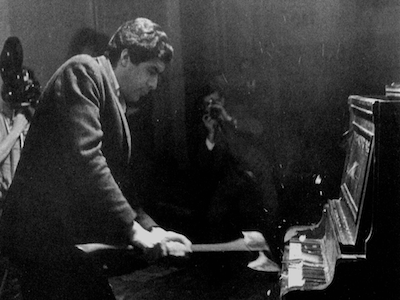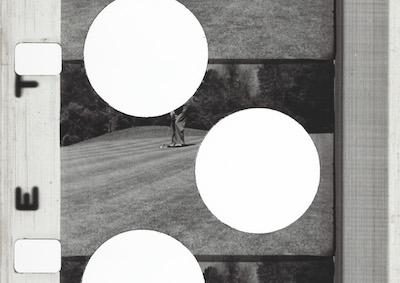Admission is free. No advance reservations. Your seat will be assigned to you when you pick up your ticket at the box office. Seats are assigned on a first come, first served basis. The box office opens one hour before the event.
Part 1: Taking an Axe and Hole Punch to Celluloid
In the late 1950s, Raphael Montañez Ortiz purchased 16mm one-reel shorts sold at local drug stores and camera shops for home viewing. Most came from Castle Films, which marketed excerpted scenes or re-edited sequences from newsreels, documentaries and Hollywood feature films. For Ortiz, who grew up listening to radio programs, these one-reel films not only brought mass media into the home, as did radio and television, they were also physical objects one could appropriate, break down and remake into something else. In this regard, he was very influenced by Dada, Duchamp and the Readymade. But he also added his own evolving interest in non-Western ritual, the unconscious and destruction within art practice. Note: to provide historical context, the source will be screened before Ortiz’s film.
Special thanks to our community partner: Los Angeles Filmforum.
Golf
U.S., 1957
The film is a ritual destruction of a 1940 sports documentary that follows three top American golfers from Pebble Beach to Augusta, Georgia. Ortiz punches holes in the film using a revolving hole punch plier with different punch sizes. As he explains, "Golf was the result of my attempt to make space in the frame, space that was non-film space, that would take over the film space. With each random hole punch, I chanted, ‘Emptiness is fullness.’” Ortiz then excerpted the final 70 seconds of the film, which have an “instructional” quality to them emphasized by veteran radio announcer Alois Havrilla’s narration.
16mm, b&w, 1 min. Premiere of restored print. Restoration funding provided by the National Film Preservation Foundation. Restored by the UCLA Chicano Studies Research Center in cooperation with the UCLA Film & Television Archive. Laboratory services provided by BB Optics, Inc.
Preceded by the source: Follow Thru (1940), from the series Sportbeams: Home Movies of the Champions from Every Field of Sport (Official Films). 16mm, b&w, 9 min.
Cowboy and “Indian” Film
U.S., 1957-58
The film is a ritual destruction of a Castle Films excerpt of a standard “Cowboys vs. Indians” scene taken from Anthony Mann’s Winchester ’73 (1950). Ortiz used a tomahawk to hack away at the 16mm film print before placing the shards into a medicine bag and shaking it while chanting. As he explained, “I was imitating Indigenous ritual to find my place in it.” He then pulled out individual pieces, splicing them together, regardless of orientation. Ortiz conducted this ritual twice, using two prints, and then excerpted a section from one of the ritual assemblages as his final work.
16mm, b&w, 2 min. Premiere of restored print. Restoration funding provided by the National Film Preservation Foundation. Restored by the UCLA Chicano Studies Research Center in cooperation with the UCLA Film & Television Archive. Laboratory services provided by BB Optics, Inc.
Preceded by the source: Guns of the West (Complete Edition, Castle Films, excerpt from Winchester ’73 [1950]).
Newsreel
U.S., 1958
The film is a ritual destruction of a Castle Films newsreel compilation for 1946 with pieces randomly selected and spliced together. There are two sound versions of Newsreel: one using Ortiz’s destruction composition "Accelerated Zen Prayer" (1968), and another using his 1989 Piano Sacrifice Ritual at Kunst Scharifeh-Mühle in Köln, Germany.
16mm, b&w, silent (with composition added), 2 min. Premiere of restored print. Restoration funding provided by the National Film Preservation Foundation. Restored by the UCLA Chicano Studies Research Center in cooperation with the UCLA Film and Television Archive. Laboratory services provided by BB Optics, Inc.
Preceded by the source: News Parade of the Year: 1946 (Headline Edition [?], Castle Films, b&w).

Part 2: Filming Destruction
While Ortiz is primarily known for his reworking of existing films and compositions, he also shot an 8mm film in the late 1950s and organized film and audio documentation of his performance and installation art since the 1960s. The arc of these works goes from the visceral aspects of destruction in art to his turn in the 1970s toward an art of healing. In both cases, these were informed by his study of neuroscience, psychoanalysis (Jungian and Neo-Freudian) and arts education (informed by Herbert Read).
Henny Penny: The Sky is Falling
U.S., 1958
Ortiz shot the film in 1958 in a chicken slaughterhouse in Brooklyn’s Coney Island area of New York City. The audio is from Ortiz’s Destruction Piano Concert at Duncan Terrace, London, England, as part of the Destruction in Art Symposium in 1966.
16mm, b&w, silent (with composition added), 8 min. Premiere of restored print. Restoration funding provided by the National Film Preservation Foundation. Restored by the UCLA Chicano Studies Research Center in cooperation with the UCLA Film & Television Archive. Laboratory services provided by BB Optics, Inc.
Piano Destruction Concert, London, England
U.S., 1966
U.S. TV reports on Ortiz piano destruction concert at the 1966 Destruction in Art Symposium (DIAS) in London that was organized by Gustav Metzger. This staged performance provides a manifesto of sorts in line with Ortiz’s “Destructivism: A Manifesto” (1962) and other writings at the time.
DCP, b&w, 5 min.
Destruction Room
U.S., 1967
Documentation of Ortiz’s piece for 12 Evenings of Manipulations at Judson Church, which he co-organized with Jon Hendricks. Other participating artists included Jean Toche, Allan Kaprow, Al Hansen, Carolee Schneemann, Lil Picard, Kate Millet, Nam June Paik, Charlotte Moorman and Ken Jacobs.
Digital file, b&w, silent (with audio added), 10 min.
Excerpt from Past Life Regression
U.S., 1979
This video is one in a series of recorded sessions directing participants through previous lives. Ortiz would use these for his dissertation, Towards an Authenticating Art (1982). This work represents a shift in Ortiz’s thought about destruction in art, from a focus on actions and objects within an arts space to a focus on the human body as the site of art itself.
DCP, color, 10 min.
Total running time: approx. 80 min.






 Mobile Navigation
Mobile Navigation

